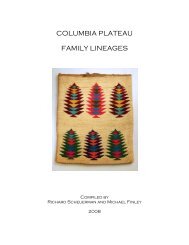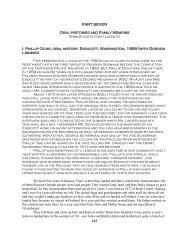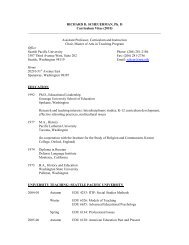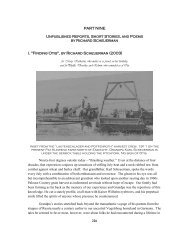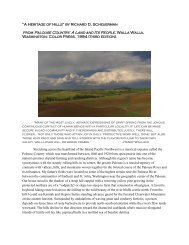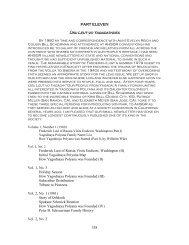THE BERRY MEADOW ARCHIVE - Mountain Light School
THE BERRY MEADOW ARCHIVE - Mountain Light School
THE BERRY MEADOW ARCHIVE - Mountain Light School
You also want an ePaper? Increase the reach of your titles
YUMPU automatically turns print PDFs into web optimized ePapers that Google loves.
PREFACE<br />
Berry Meadow Archive Origins<br />
by Richard Scheuerman<br />
In the summer of 1766, eighty intrepid families from the rolling Vogelsberg district north of<br />
Frankfurt, a. M. anxiously gathered in the city of Büdingen to begin a momentous and perilous journey<br />
eastward. They were fleeing poverty and oppressive conditions that had long prevailed in Hesse in hopes<br />
of finding new lives of opportunity in Russia in response to Tsarina Catherine the Great‟s famed 1763<br />
“Manifesto of the Empress” inviting foreigners to colonize the vast untamed Volga region. These eighty<br />
families joined together for the year-long trek via St. Petersburg and Moscow and eventually reached their<br />
destination in August 1767 when they founded the village of Yagodnaya Polyana (Berry Meadow) in a<br />
wooded valley surrounded by rolling grasslands about forty miles north of Saratov on the hilly, western<br />
side (Bergseite) of the Volga. After several brutal years adjusting to conditions on the Russian frontier,<br />
these German families and others who established a hundred other Volga German villages in the region<br />
began to slowly prosper. In the 1850s the expanding colonists were given additional lands east of the<br />
Volga where the residents of Yagodnaya Polyana and neighboring Pobotschnoye established New<br />
Yagodnaya (1855), Schöntal (1856), Schöndorf (1857), and Schönfeld (1858) in the province of Samara<br />
along a tributary of the Volga, the Yeruslan River. In spite of their evocative names (Pleasant Valley,<br />
Pleasant Village, Pleasant Field), agricultural life in the drier Wiesenseite (Plains Side) of the Volga was<br />
challenging and remote from the mother colonies which explains why the first immigrants from these<br />
families to journey to America came from these daughter colonies.<br />
Unpopular policies undertaken by Tsar Alexander II‟s in the 1870s to Russify the colonists,<br />
religious persecution, and economic challenges led many Volga Germans to once again seek new<br />
opportunities. For these reasons they began immigrating to United States as early as 1876. Over the next<br />
four decades those with ties to Yagodnaya Polyana settled in Kansas, Oregon, Washington, Oklahoma,<br />
Maryland, New York, and Wisconsin as well as in Alberta, Canada, and Argentina. The communities<br />
formed by “Yagaders” in these places continued to perpetuate cultural distinctions well into the twentieth<br />
century. Moreover, in the course of two centuries members of virtually all the original colonist families<br />
had extensively intermarried with each other. In the 1960s of my youth in Washington‟s rural Palouse, for<br />
example, our cousins and closest neighbors bore names like Lautenschlager, Repp, Lust, Schmick/Smick,<br />
Gerlitz, Kleweno, and Morasch—each descended from a single family that had gathered for the trek from<br />
Hesse to Russia that summer day in 1766. Persons interested in their heritage were challenged by these<br />
familial complexities, and the fact that access to Russian census records and other archival materials was<br />
denied throughout the Soviet period. Contact with Volga German families who had remained in Russia<br />
and subsequently deported to Central Asia and Siberia during World War II was also severely restricted.<br />
I became aware as a youth raised near the rural community of Endicott, Washington that a vast<br />
constellation of relatives safeguarded knowledge of our family‟s heritage. This awareness was preserved<br />
in stories handed down from generation to generation by individuals like my Grandfather Karl<br />
Scheuerman and our Great Aunt Lizzie Repp, in the writings of Great Aunt Mae Poffenroth Geier,<br />
through tape-recorded interviews of Endicott elders by historian Gordon Lindeen in the 1950s, and in the<br />
many old photograph scrapbooks featuring faded images of stolid, unsmiling relatives lined up around a<br />
15



